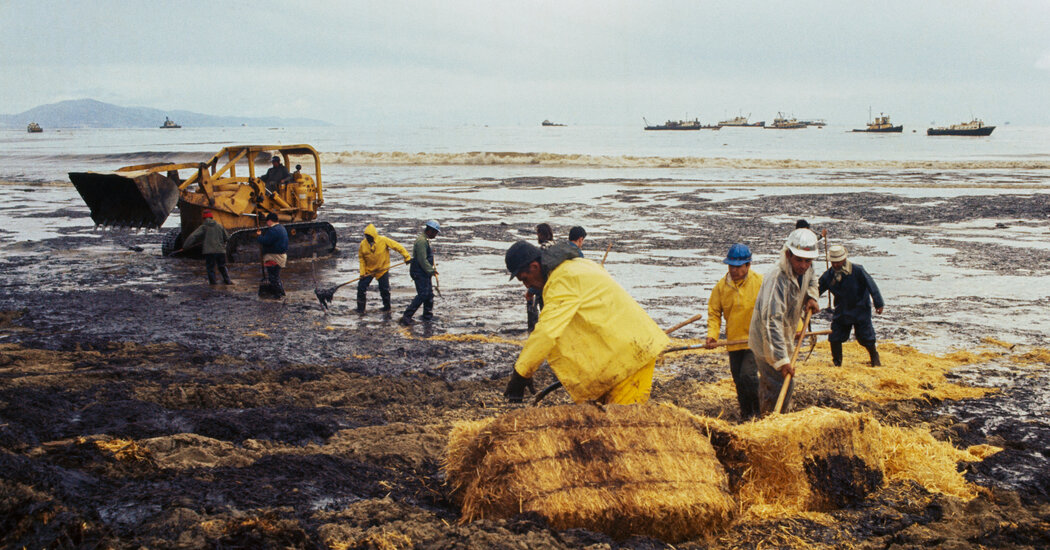Happy Earth Day.
As you probably know, April 22 is a day set aside for appreciating the environment and demonstrating support for laws that protect it.
The tradition dates back to the first Earth Day in 1970, which led to the passage of landmark environmental legislation in the United States. It was a momentous event that helped create the modern environmental movement — one whose origins can be traced to the shores of California.
Here’s a little history: Americans in the 1960s were becoming increasingly aware of the ways their behavior could be harming the natural world.
Rachel Carson’s “Silent Spring,” published in 1962, detailed how pesticides hurt the environment. The polluted Cuyahoga River in Cleveland kept catching fire. The California condor faced extinction. Panic was brewing about a global overpopulation crisis.
But it was a massive oil spill in 1969 off the coast of Santa Barbara that ultimately served as a catalyst for Earth Day.
“Santa Barbara brought it home to people — that this could affect the well-to-do, this could affect the poor and, of course, the natural environment,” said Denis Hayes, national coordinator of the original Earth Day. “It began to weave all of these issues into a common narrative.”
In late January 1969, millions of gallons of crude oil began to pour into the waters off Santa Barbara. It was the biggest oil spill in U.S. history at the time (though not anymore) — and it was televised.
From their living rooms, Americans watched as sandy California beaches turned black and birds’ feathers were slathered in tar. The corpses of seals and dolphins washed in with the tide.
The catastrophe gave Gaylord Nelson, a senator from Wisconsin, the idea to hold a national teach-in about environmentalism. In the fall of 1969, Nelson recruited Hayes, then a 25-year-old graduate student at Harvard, to organize the event, which would eventually turn into Earth Day.
Hayes told me that it has never been entirely clear to him why the oil spill captured the public’s imagination the way it did. “There was something about Santa Barbara that I think no one could explain, except that I think the time was ripe,” he told me.
Hayes and a team of young activists began working to organize marches and other events to take place across the country on April 22, 1970. In an article published in March that year, The New York Times described Hayes as a man who “hops around the country like an ecological Dustin Hoffman, preaching mobilization for environmental reform with sober but evangelical militance.” (If you’re interested, my colleague John Schwartz wrote an excellent profile of Hayes a few years back.)
The coast-to-coast demonstrations on that first Earth Day drew a stunning 20 million Americans, one-tenth of the country’s population at the time. The enormous turnout helped prompt unprecedented action at the state and federal levels to safeguard the environment.
In the Golden State, where the oil spill began to heavily influence political discourse, the California Environmental Quality Act was adopted in 1970. Two years later, voters approved the creation of the California Coastal Commission, a state agency in charge of protecting the seashore.
At the national level, Congress passed the Clean Air Act, the Clean Water Act and the Endangered Species Act, and President Richard M. Nixon created the Environmental Protection Agency. “All of a sudden, in rapid succession, they pass law after law after law,” said Kathleen Rodgers, president of EarthDay.org, the nonprofit behind the annual events.
She called it nothing short of a miracle.
Today, Earth Day is celebrated in 192 countries. Its mission includes curbing plastic pollution, supporting regenerative agriculture and combating climate change.
Hayes, now 77, spearheaded Earth Day events for half a century. He lived in Seattle for many years, but had long promised his wife that they would retire “somewhere sunny.”
Now, the pair has settled in, of all places, Santa Barbara.
For more:
Where we’re traveling
Today’s tip comes from Barry Schiller, who recommends visiting Davis:
“Though I now like living in New England, I always visit Davis, where I went to graduate school at U.C. Davis and learned about cycling. A visitor could rent a bike and explore a campus that was deliberately developed in a bicycle-oriented way; ride a bike path along Putah Creek to look at California vegetation including a redwood grove; and pedal downtown for a variety of cafes, bookstores and the Spanish-style Southern Pacific railroad station still in use by Amtrak, which is a good way to get to Davis from the Bay Area.”
Tell us about your favorite places to visit in California. Email your suggestions to [email protected]. We’ll be sharing more in upcoming editions of the newsletter.
Tell us
How are you feeling about the latest mask rules for public transit in your area?
Email us at [email protected] with your thoughts.
And before you go, some good news
It’s finally happening.
Groundbreaking is scheduled for Friday on construction of the world’s biggest wildlife crossing. The bridge over U.S. 101 in Agoura Hills will eventually allow safe passage for mountain lions, coyotes, snakes and more.
For years, the busy 10-lane freeway has been an almost impenetrable barrier for wildlife and it appears to have caused a worrisome lack of genetic diversity within local animal populations, according to scientists at the National Park Service. There are signs of inbreeding among local mountain lions, most likely because of habitat fragmentation, they say.
“It’s super exciting to see the science that we’ve worked so hard on for many years result in concrete action to benefit wildlife,” Seth Riley, the wildlife branch chief for Santa Monica Mountains National Recreation Area, said in a statement. “This is a pivotal moment for conservation and for our park.”
















